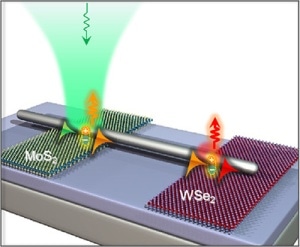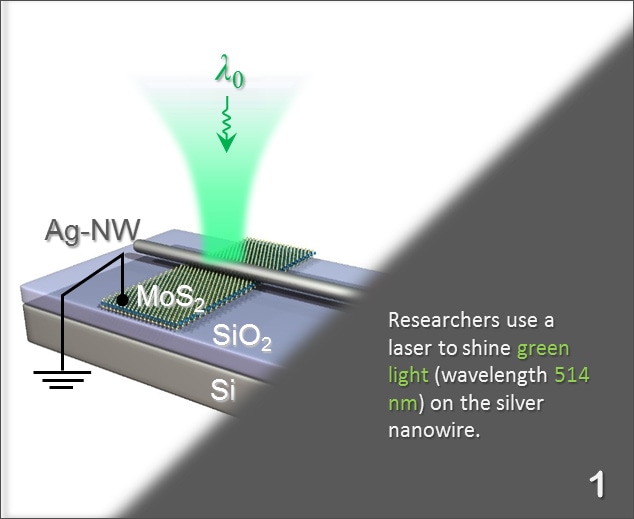Nov 29 2016
 The multiplexer device with one input and two outputs. The plus-minus couple indicates the exciton. Credit: IBS
The multiplexer device with one input and two outputs. The plus-minus couple indicates the exciton. Credit: IBS
The computers of the future could work nearly at the speed of light. Nanophotonics, the study of the behavior of light at the nanometer scale, could bring the speed of the current technology into a totally different level.
The Center for Integrated Nanostructure Physics (CINAP) at the Institute for Basic Science (IBS) has created three key components of an optical circuit that works with light. These devices combine the benefits of electronics and photonics on the same platform.
While researchers are slowly approaching the end point of Moore's Law, a state where the dimension of transistors cannot be shrunk much further; the future of big data processing demands high performance computers with higher speed. Researchers believe that if they develop computers that process information through light, rather than electrons, computers will be able to work much faster.
However, the wavelength of light is larger compared to the diameter of the silicon fiber at nanometer dimensions and due to this, some light can be lost. A solution that can be derived from surface plasmons could help to control the propagation of light in matter.
These are electromagnetic waves that propagate along the surface of some conductive materials such as gold, silver, copper and aluminum. Optical information can be transmitted almost at the speed of light and in extremely small level using surface plasmons.
IBS researchers used surface plasmons in silver nanowires and 2D semiconductors such as molybdenum disulphide (MoS2) to develop three key components for optical communication: optical multiplexers, optical signal detectors, and optical transistors.
These devices work due to a phenomenon named plasmon-exciton-plasmon interconversion. The below graphics illustrate this process step-by-step:








IBS researchers built the optical transistor by connecting the silver nanowire to a thin piece of MoS2. The light that shines on the device is transformed into surface plasmon, then to exciton, back to surface plasmon and finally emitted as light with a shorter wavelength than the initial input. For instance, the output light can be red if the input light is green.
Wavelength multiplexing devices were achieved in a similar way, however, instead of using only a thin piece of MoS2, the researchers used a range of three different types of 2D semiconductor materials that emit light at different wavelengths. In this structure, for instance, a single input light (violet color) produces three output lights (red, blue and green).
The propagation of optical signals along silver nanowire can also be transformed and detected as electrical signals with an optical signal detector.
The originality of this paper arises from the exciton-plasmon interconversion. We published before the conversion of exciton to plasmon, and from plasmon to exciton using silver nanowire/2D semiconductor hybrids, but this is the first time that we can complete the circle going from plasmons to excitons and back to plasmons. Using this concept, we created optical transistors and multiplexers.
Hyun Seok Lee, Professor